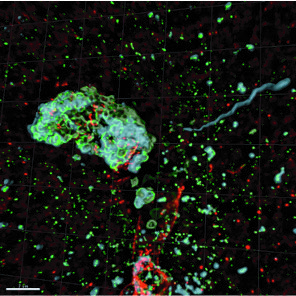 help
help
Pneumonanodiams
Use of nanodiamonds to inhibit the invasion of endothelial cells by pneumococcus.
Summary
Pneumococcus (PN) is a commensal bacterium of the nasopharynx, responsible for invasive infections and the main agent of community bacterial meningitis. The emergence of multi-antibiotic resistant PN strains requires the development of new infection control strategies. In this context, nanodiamonds (NDs) have received increased attention in recent years due to their promising biomedical and antimicrobial properties. In PNEUMONANODIAMS, we propose to characterize the anti-bacterial activity of NDs towards PN. We will functionalize NDs with ligands that target PN and test their ability to prevent the growth of bacteria and adhesion to endothelial cells.

3D reconstruction of plans by confocal microscopy of a slice of the brain of an infected mouse after intravenous injection of PN. Green fluorescent immunolabelling: PN capsule; red: vascular endothelium; gray: GFAP (glial fibrillary acid protein). Scale bar = 7 m.
Description
The antimicrobial properties of NDs have been the subject of numerous studies in recent years. Non-functionalized NDs can prevent the formation of bacterial biofilms and have more pronounced anti-bacterial activity on certain species. The bactericidal activity may be associated with the surface groups of partially oxidized and negatively charged NDs, in particular acid anhydrides and especially carboxylic acids. This activity was especially characterized for NDs resulting from synthesis by detonation (DNDs) which results in small round nanoparticles of primary size 5 nm. NDs produced by synthesis under high pressure and high temperature followed by fine grinding (Milled Nanodiamonds - MNDs) are larger, around 30 nm for the smallest, and more angular in shape. Two studies published to date suggest that the anti-bacterial activity of MNDs is linked to bactericidal activity or the aggregation of bacteria. In general, the anti-bacterial activity of NDs is still poorly understood and could also depend on their size or shape. We will develop functionalized NDs targeting virulence factors expressed on the surface of PN strain. Through these functionalizations, we will optimize the anti-infectious activity of NDs by increasing the interactions of NDs with bacteria and by inhibiting the interactions of PN with host cells. This will be the first use of functionalized NDs targeting the pneumococcus. In addition, unlike DNDs. It is possible to make the MNDs fluorescent (FNDs) by creating within them colored nitrogen-gap centers (NV) emitting in the far red which do not flicker or whiten. We will take advantage of the extreme stability of the fluorescence of functionalized FNDs to develop a new procedure for monitoring the permeabilization of the endothelial monolayer of the cerebral macrovasculature by the PN.
